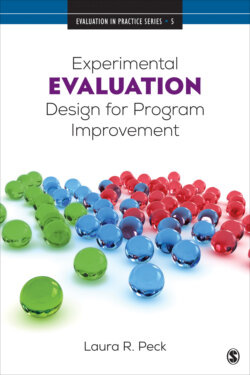Читать книгу Experimental Evaluation Design for Program Improvement - Laura R. Peck - Страница 13
На сайте Литреса книга снята с продажи.
Large-Scale Experiments
ОглавлениеPerhaps the most commonly thought of experiments are what I will refer to as “large-scale” impact studies, usually government-funded evaluations. These tend to be evaluations of federal or state policies and programs. Many are demonstrations, where a new program or policy is rolled out and evaluated. For example, beginning in the 1990s, the U.S. Department of Housing and Urban Development’s Moving to Opportunity Fair Housing Demonstration (MTO) tested the effectiveness of a completely new policy: that of providing people with housing subsidies in the form of vouchers under the condition that they move to a low poverty neighborhood (existing policy did not impose the neighborhood poverty requirement).
Alternatively, large-scale federal evaluations can be reforms of existing programs, attempts to improve incrementally upon the status quo. For instance, a slew of welfare reform efforts in the 1980s and 1990s tweaked aspects of existing policy, such as changing the tax rate on earnings and its relationship to cash transfer benefit amounts, or changing the amount in assets (such as a vehicle’s value) that a person could have while maintaining eligibility for assistance. These large-scale experiments usually consider broad and long-term implications of policy change, and, as such, take a fair amount of time to plan, implement, and generate results.
This slower process of planning and implementing a large-scale study, and affording the time needed to observe results, is also usually commensurate with the importance of the policy decisions: Even small effects of changing the tax rate on earnings for welfare recipients can result in large savings (or costs) nationally. Although we might hope for—or seek out—policy changes that have large impacts, substantial, useful policy learning has come from this class of experimental evaluations (e.g., Gueron & Rolston, 2013; Haskins & Margolis, 2014). For example, the experimentation that focused on reforming the U.S. cash public assistance program was incremental in its influence. That program’s evaluation—Aid to Dependent Children (ADC) and Aid to Families with Dependent Children (AFDC) from 1935 until 1996 and Temporary Assistance for Needy Families (TANF) since then—amassed evidence that informed many policy changes. Evidence persuaded policymakers to change various aspects of the program’s rules, emphasize a work focus rather than an education one, and end the program’s entitlement.
